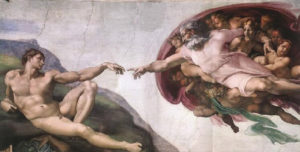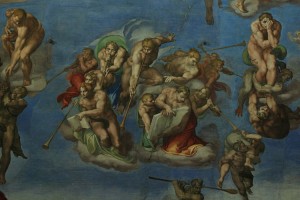The Sistine Chapel, or Cappella Sistina in Italian, is an extraordinary achievement, serving as the main chapel of the Apostolic Palace in the Vatican, dedicated to the Assumption of Mary. It takes its name from Pope Sixtus IV della Rovere, who initiated its construction between 1475 and 1481.
On one hand, it is one of the most famous artistic works in Rome, distinguished by the greatest masterpiece of Michelangelo Buonarroti, which can be explored during a visit to the Vatican Museums. On the other hand, it hosts the conclaves for the election of the Pope and official ceremonies.
The visit to the Sistine Chapel ranks number 4 in our Top 30 in Rome.
The Frescoes of the Sistine Chapel
The frescoes adorning the walls of the Sistine Chapel are among the most renowned artworks in the world. These illustrations form a “Biblia pauperum,” perhaps the most significant depiction of Judeo-Christian theology.
The Vault with Genesis
On the vault, Michelangelo painted episodes from the Old Testament (1508-1512): Genesis, Creation of Man, The Flood, Noah, and more. In the lunettes and corners, prophets, sibyls, and ancestors of Christ are depicted.
Michelangelo’s Last Judgment: A Monumental Fresco
Later, Clement VII de Medici commissioned the same great artist to paint the Last Judgment (1535-1541) on the back wall. This massive 20-meter-high fresco portrays the glorious return of Christ as described in the scriptures. It features a crowd of figures surrounding Christ and the Virgin, originally depicted nude but later “clothed” to conceal their intimate anatomy. This “dynamic” scene contrasts with typical solemn representations, with highly expressive and lively characters full of movement.
Frescoes on the Other Walls: Botticelli, Perugino, Ghirlandaio
The other walls are decorated with scenes illustrating the Stories of Moses on the south wall and the New Testament on the north wall, as well as portraits of Popes. These were painted by great Italian artists of the late 15th century: Sandro Botticelli (episodes of Moses, Temptation of Christ), Pietro Perugino (Moses’ Journey to Egypt, Baptism of Christ), Pinturicchio, Domenico Ghirlandaio (The Calling of the First Apostles Peter and Paul), Piero di Cosimo, Cosimo Rosselli (Sermon on the Mount, Last Supper, Tables of the Law).
In the 16th century, the frescoes on the entrance wall were redone: Hendrik van den Broeck repainted Ghirlandaio’s Resurrection of Christ, and Matteo da Lecce repainted Signorelli’s Dispute over the Body of Moses.
The floor is covered with a beautiful 15th-century Cosmatesque marble pavement.
Suggested Guided Tours of the Sistine Chapel and Tickets
Visiting the Sistine Chapel: Tickets, Hours, and Info
Hours and Tickets for the Sistine Chapel
The chapel is generally open Monday to Saturday from 8:00 AM to 8:00 PM (last entry at 6:00 PM). Extended hours on Fridays and Saturdays.
Closures: Sundays, and in 2025 on January 1 and 6, February 11, March 19, April 21, May 1, June 29, August 15 and 16, November 1, December 8, 25, and 26.
2025 Prices: Full price €20 / Reduced €8
Tickets, guided tours, and combined options: Official Website – On Tiqets – On GetYourGuide
Where is the Sistine Chapel: Rome Map
The chapel is located within the Vatican Museums tour.
If you see this after your page is loaded completely, leafletJS files are missing.
Resources and Links
- 2025 Vatican Museums Schedule and exceptional openings/closures
- City website turismoroma
- Page on the official museum website
Tips and FAQ for Visiting the Sistine Chapel
How Long Does It Take to Visit the Sistine Chapel?
Ideally, visiting the chapel takes about 30 minutes, but as it is part of the Vatican Museums, the full visit can take 3 to 4 hours. Note that the route through the museum to reach the chapel is lengthy—about 1.5 hours at a standard pace.
What’s the Best Time to Visit the Sistine Chapel?
To avoid heavy crowds, it’s best to visit early in the morning at 8:00 AM, especially during peak season (spring-summer), or late in the day, particularly with the extended Friday and Saturday hours.
How to Better See Michelangelo’s Frescoes
The vault is nearly 20 meters high, so bringing binoculars is recommended to fully appreciate the details.
Combining the Visit with St. Peter’s Basilica
Many guided tours (via GetYourGuide or the official website) combine the Sistine Chapel with the basilica. You can go directly from the chapel to the basilica, bypassing outdoor lines.
Booking Your Tickets
Book tickets in advance: Purchase them on the official Vatican Museums website or through platforms like GetYourGuide to avoid long queues (up to 2 hours in peak season).









